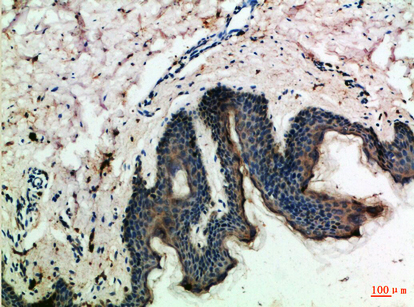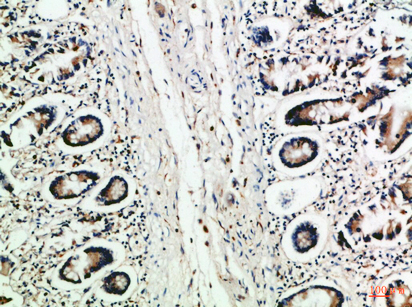MCP-3 Polyclonal Antibody
- Catalog No.:YT6046
- Applications:IHC;IF;ELISA
- Reactivity:Human;Rat;Mouse;
- Target:
- MCP-3
- Fields:
- >>Cytokine-cytokine receptor interaction;>>Viral protein interaction with cytokine and cytokine receptor;>>Chemokine signaling pathway;>>IL-17 signaling pathway
- Gene Name:
- CCL7 MCP3 SCYA6 SCYA7
- Protein Name:
- C-C motif chemokine 7 (Monocyte chemoattractant protein 3) (Monocyte chemotactic protein 3) (MCP-3) (NC28) (Small-inducible cytokine A7)
- Human Gene Id:
- 6354
- Human Swiss Prot No:
- P80098
- Mouse Gene Id:
- 20306
- Mouse Swiss Prot No:
- Q03366
- Immunogen:
- Synthetic peptide from human protein at AA range: 50-99
- Specificity:
- The antibody detects endogenous MCP-3
- Formulation:
- Liquid in PBS containing 50% glycerol, 0.5% BSA and 0.02% sodium azide.
- Source:
- Polyclonal, Rabbit,IgG
- Dilution:
- IHC 1:50-200, ELISA 1:10000-20000. IF 1:50-200
- Purification:
- The antibody was affinity-purified from rabbit antiserum by affinity-chromatography using epitope-specific immunogen.
- Concentration:
- 1 mg/ml
- Storage Stability:
- -15°C to -25°C/1 year(Do not lower than -25°C)
- Other Name:
- C-C motif chemokine 7 (Monocyte chemoattractant protein 3;Monocyte chemotactic protein 3;MCP-3;NC28;Small-inducible cytokine A7)
- Background:
- This gene encodes monocyte chemotactic protein 3, a secreted chemokine which attracts macrophages during inflammation and metastasis. It is a member of the C-C subfamily of chemokines which are characterized by having two adjacent cysteine residues. The protein is an in vivo substrate of matrix metalloproteinase 2, an enzyme which degrades components of the extracellular matrix. This gene is part of a cluster of C-C chemokine family members on chromosome 17q. [provided by RefSeq, Jul 2008],
- Function:
- function:Chemotactic factor that attracts monocytes and eosinophils, but not neutrophils. Augments monocyte anti-tumor activity. Also induces the release of gelatinase B. This protein can bind heparin. Binds to CCR1, CCR2 and CCR3.,online information:CCL7 entry,PTM:O-glycosylated.,similarity:Belongs to the intercrine beta (chemokine CC) family.,subunit:Monomer.,
- Subcellular Location:
- Secreted.
- Expression:
- Blood,Colon,Osteosarcoma,
- June 19-2018
- WESTERN IMMUNOBLOTTING PROTOCOL
- June 19-2018
- IMMUNOHISTOCHEMISTRY-PARAFFIN PROTOCOL
- June 19-2018
- IMMUNOFLUORESCENCE PROTOCOL
- September 08-2020
- FLOW-CYTOMEYRT-PROTOCOL
- May 20-2022
- Cell-Based ELISA│解您多样本WB检测之困扰
- July 13-2018
- CELL-BASED-ELISA-PROTOCOL-FOR-ACETYL-PROTEIN
- July 13-2018
- CELL-BASED-ELISA-PROTOCOL-FOR-PHOSPHO-PROTEIN
- July 13-2018
- Antibody-FAQs
- Products Images

- Immunohistochemical analysis of paraffin-embedded Human-skin, antibody was diluted at 1:100

- Immunohistochemical analysis of paraffin-embedded Human-colon, antibody was diluted at 1:100



